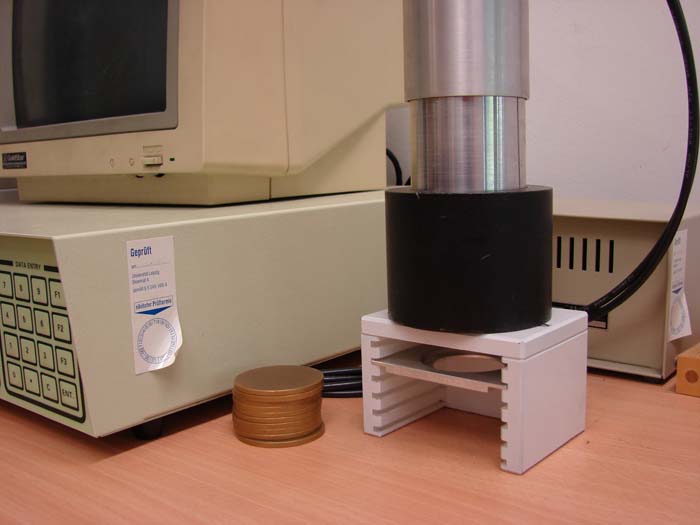Gamma Spectroscopy & Alpha/Beta Counting
In the realm of radiation and nuclear testing, gamma spectroscopy and alpha/beta counting are indispensable analytical techniques used to quantify radioactive isotopes. These methods find critical application in ensuring safety, compliance, and quality control across various sectors such as environmental monitoring, medical technology, and nuclear waste management.
Gamma spectroscopy involves the measurement of gamma radiation emitted by a sample, which allows for the identification and quantification of specific radionuclides present within it. This technique is particularly useful in scenarios where precise knowledge about the elemental composition of materials is required. The process entails irradiating the sample with an external gamma source, causing the emission of characteristic gamma rays that can then be detected using a high-purity germanium (HPGe) detector.
Alpha and beta counting methods, on the other hand, are used for detecting alpha and beta particles emitted by radioactive materials. These particles are ionizing radiation that can be measured with specific detectors designed to capture their interaction with matter. Alpha counting is often applied in the analysis of nuclear fuel rods or in environmental samples where alpha-emitting isotopes like Americium-241 (Am-241) and Plutonium-239 (Pu-239) are present.
Both methods play a pivotal role in ensuring that radioactive materials adhere to stringent safety standards set by regulatory bodies worldwide. The precision and reliability of these techniques are paramount, making them essential tools for quality managers, compliance officers, R&D engineers, and procurement specialists.
Scope and Methodology
| Aspect | Description |
|---|---|
| Sample Preparation | Ensuring the sample is free from contaminants that could interfere with detection. This involves thorough cleaning, drying, and sometimes encapsulation for alpha/beta counting. |
| Instrumentation | For gamma spectroscopy, a HPGe detector connected to appropriate software. For alpha/beta counting, specific detectors sensitive to the respective particle types are used. |
| Data Acquisition | Involves setting up measurement parameters such as energy resolution and count time to optimize accuracy. |
| Analysis | The collected data is processed using specialized software that identifies and quantifies the isotopes present in the sample based on their unique gamma ray energies or particle interactions. |
The methodology also includes quality assurance measures such as calibration of instruments against known standards, regular maintenance checks, and validation of results against international standards like ISO 10245-1 for gamma spectroscopy. This ensures that the data generated is reliable and can be trusted in regulatory contexts.
International Acceptance and Recognition
The techniques of gamma spectroscopy and alpha/beta counting are widely recognized internationally, with standards such as ISO 10245-1 for gamma ray spectrometry and IEC 60531 for alpha and beta particle measurement providing robust frameworks. These standards ensure that the methods employed are consistent across different laboratories, thereby enhancing comparability of results.
Regulatory bodies like the International Atomic Energy Agency (IAEA) and national agencies such as the United States Nuclear Regulatory Commission (NRC) have endorsed these techniques for their reliability and precision. Compliance with these standards is crucial for industries dealing with radioactive materials, ensuring that all operations are conducted safely and in accordance with global best practices.
The widespread acceptance of gamma spectroscopy and alpha/beta counting in international forums underscores the importance of these methods in maintaining high-quality standards across various sectors. Their use contributes significantly to public safety and environmental protection, making them indispensable tools for professionals in radiation and nuclear testing.
Use Cases and Application Examples
| Application | Description |
|---|---|
| Nuclear Waste Disposal | Gamma spectroscopy is used to assess the radioactivity levels of waste materials, ensuring they meet disposal criteria. Alpha/beta counting helps in verifying that these wastes are safe for handling and storage. |
| Mining Industry | In mining, gamma spectroscopy aids in identifying naturally occurring radioactive material (NORM) contamination in mineral samples. Alpha/beta counting can be used to verify the presence of radionuclides during ore processing. |
| Medical Device Manufacturing | Gamma spectroscopy ensures that medical devices comply with radiation limits set by regulatory bodies, while alpha/beta counting checks for contamination in materials used in device production. |
| Environmental Monitoring | Gamma spectroscopy can monitor environmental samples for the presence of radionuclides released into air, water, or soil. Alpha/beta counting is vital for detecting low-level emissions from industrial processes. |
In conclusion, gamma spectroscopy and alpha/beta counting are versatile techniques with broad applicability across multiple sectors. Their use not only ensures safety but also enhances the reliability of operations involving radioactive materials. By adhering to international standards and best practices, professionals can leverage these methods to achieve consistent, accurate results that meet regulatory requirements.





